- Top Employee Onboarding Software
- Why Use Employee Onboarding Software?
- Key Features of Effective Onboarding Software
- How To Choose The Right Onboarding Software?
- Which is the Best Onboarding Software?
- Frequently Asked Questions (FAQs)
- What Is Upskill And Reskill?
- Difference Between Reskilling And Upskilling
- Upskilling for Workplace Advancement
- Reskilling for Career Transformation
- Crafting Successful Upskill and Reskill Strategies
- Upskill And Reskill Strategizing: Things to Keep in Mind
- Measuring the Impact of Skill Development Initiatives
- Frequently Asked Questions
- What’s a Skill Gap?
- Employee Skill Gap Analysis: Why Do We Need It?
- How To Conduct Employee Skill Gap Analysis?
- Addressing Skill Gaps Through Training and Hiring
- Utilizing Skills Gap Analysis for Strategic Planning
- Leveraging Employee Skill Gap Analysis: Things To Keep In Mind
- Frequently Asked Questions
- Transformative Role of AI in Talent Acquisition
- Impact of AI on Business Recruiting
- Overcoming Challenges in AI-Driven Talent Acquisition
- Starting with AI in Talent Acquisition
- Future Landscape of AI in Talent Acquisition
- Frequently Asked Questions
- HR In The Hot Seat - Challenges With Evolving Workforce
- Mastering Effective HR Management: Tips For Overcoming Challenges
- Summing Up
- The Future of HR: Key Trends for 2024
- Skill-Based Hiring
- Prioritizing Employee Experience, Engagement & Well-being
- AI-Empowered Workforce Evolution and Its Impact
- Taking Diversity, Equity, and Inclusion Beyond Mandates
- Hybrid and Remote Work
- Embracing the Gig Economy and Blended Workforce
- Transparent HR Practices
- Climate Change Adaptation in HR Practices
- Leveraging HR Analytics for Data-Driven Decisions
- Continuous Learning & Development to Improve Productivity
- The Office Buzz in 2024
- Bottom Line - HR Operating Model Needs A Shift
- Importance and Impact of Recognizing Employee Birthdays
- Professional Birthday Wishes for Employees (All Experience Levels)
- Personalized Birthday Wishes for Employees in Different Roles
- Fun Birthday Wishes for Employees (with Templates)
- Birthday Wishes for Remote Employees
- Heartfelt Birthday Wishes for Employees
- Belated Birthday Wishes for Employees
- Simple & Sweet Birthday Wishes for Employees
- Celebrating Employee Birthdays: Ideas and Traditions
- Tips and Ideas for Sending Birthday Wishes to Employees
- Closing Thoughts
- Frequently Asked Questions
- What Is An Employee Referral?
- Benefits of Implementing Employee Referral Programs
- Setting Up an Effective Employee Referral Program
- Employee Referral Email
- Employee Referral Scheme
- Overcoming Challenges of Employee Referrals
- Companies with Best Employee Referral Programs
- Employee Referral Programs: Best Practices
- Closing Thoughts
- Frequently Asked Questions (FAQs)
- Importance of Team Building Activities
- Types of Team Building Activities
- Outdoor Team Building Activities for Employees
- Indoor Team Building Activities for Employees
- Easy Team Building Activities for Remote Employees
- Team Building Activities For New Employees (Icebreakers)
- Fun Team Building Activities for Different Goals
- To Boost Communication and Collaboration
- To Reduce Stress Levels and Promote Well-being
- Aligning Team Purpose and Values with Strategic Activities
- Final Remarks
- Frequently Asked Questions
- Importance of Employee Appreciation Quotes
- Work Appreciation Quotes for Employees
- Employee Appreciation Quotes for Hard Work Recognition
- Employee Appreciation Quotes for Teamwork and Collaboration
- Appreciation Quotes for Celebrating Employee Anniversaries and Milestones
- Employee Appreciation Quotes for Strong Work Ethics
- Employee Appreciation Quotes for Project & Goal Completion
- Employee Appreciation Quotes for Quality of Work
- Employee Appreciation Quotes for Creativity and Innovation
- Appreciation Quotes for Managers
- Peer-to-Peer Employee Appreciation Quotes
- Appreciation Quotes for Employees Leaving the Company
- Employee Appreciation Quotes for Thoughtful Gestures
- Funny Employee Appreciation Quotes
- Short Employee Appreciation Quotes
- Employee Appreciation Quotes for Different Roles
- Employee Appreciation Quotes for Senior Leadership
- Creative Ways to Use Employee Appreciation Quotes
- Summary
- Frequently Asked Questions (FAQs)
- What is Employee Satisfaction?
- Importance of Employee Satisfaction
- Objectives of Employee Satisfaction
- Employee Satisfaction vs. Employee Engagement
- Key Reasons for Employee Dissatisfaction
- Strategies for Improving Employee Satisfaction
- Ways to Measure Employee Satisfaction
- Best Practices for High Employee Satisfaction
- Final Remarks
- Frequently Asked Questions (FAQs)
- How to Craft Effective Employee Appraisal Comments
- Key Areas to Focus in Performance Review
- Comments On Hard Work & Dedication
- Assessing Interpersonal Skills
- Evaluating the Ability to Collaborate & Work in Teams
- Gauging Punctuality
- Commenting on Communication Style
- Reviewing Time Management and Productivity
- Leadership in Performance Appraisals
- Assessing Creativity & Innovation
- Evaluating Problem-Solving Abilities
- Recognizing Flexibility and Dependability in Reviews
- Employee Appraisal Comments for Different Roles
- Summary
- Frequently Asked Questions (FAQs)
- Employee Grievance Meaning
- Importance of Employee Grievance Process
- Types of Workplace Grievances
- Reasons for Employee Grievances
- Employee Grievance Procedure
- Steps in the Employee Grievance Handling Process
- Employee Grievance Form Example
- Final Remarks
- Frequently Asked Questions (FAQs)
- What is Company Culture?
- Importance of Company Culture
- Types of Company Culture
- Factors Contributing to Organizational Culture
- Assessing & Developing Corporate Culture
- Company Culture - It’s not just Perks or Feels
- Good Company Culture Examples
- Developing Company Culture: Best Practices
- Closing Thoughts
- Frequently Asked Questions (FAQs)
- What is Employee Empowerment?
- Benefits of Empowering Employees
- Employee Empowerment vs. Micromanagement
- Strategies for Effective Employee Empowerment
- Role of Managers in Fostering Empowerment
- Organizational Structure Supporting Empowerment
- Overcoming Barriers to Employee Empowerment
- Frequently Asked Questions (FAQs)
- What is Employer Branding?
- Importance of Employer Branding Strategy
- How to Build an Employer Branding Strategy?
- Strategies for Building a Strong Employer Brand
- How to Measure and Boost Your Employer Branding Success?
- Examples of Strong Employer Brand Strategy
- Best Practices for an Effective Employer Branding Strategy
- Closing Thoughts
- Frequently Asked Questions (FAQs)
- What are Employee Wellness Programs?
- Importance of Employee Wellness Programs
- Examples of Employee Wellness Programs
- Real-Life Examples of Corporate Wellness Programs
- Strategies for Encouraging Participation
- Supporting Diverse Employee Needs
- Creating Comprehensive Wellness Programs
- Measuring the Impact on Business and Employees
- Closing Thoughts
- Frequently Asked Questions (FAQs)
- What is Talent Management?
- Developing a Winning Talent Management Strategy
- Models and Frameworks
- Tips for Framing Effective Talent Management Strategy
- Looking Ahead: Recent Trends in Talent Management
- Frequently Asked Questions
- Role of AI in HR: Addressing Common Challenges
- Artificial Intelligence in HR Processes
- AI Tools for HR Functions
- How to Adopt AI in HR?
- Addressing Challenges of AI in HR
- Ethical and Responsible AI Use
- The Future of AI in HR
- Closing Thoughts
- Frequently Asked Questions
- What is Performance Management?
- Elements of Effective Performance Management
- Performance Management Cycle
- Differentiating Performance Management
- Benefits of Performance Management With Examples
- Challenges faced in Performance Management and their Solutions
- Future Trends in Performance Management
- Frequently Asked Questions
- Changing Role of HRM
- Changing Role Of HR Manager
- Technology and the Changing Role of HRM
- The Rise of AI and Machine Learning in HR
- Mobile Technology's Impact on HR Practices
- The Significance of People Analytics in HR
- Navigating the Future of HR Technology
- Final Remarks
- Frequently Asked Questions
- Compensation Management Meaning
- Compensation Types
- Breaking Down The Compensation Management Process
- HR Software for Compensation Management
- Current Trends in Compensation Management
- Frequently Asked Questions
- Defining Flexible Work Arrangements
- Flexible Working: Advantages for Businesses
- Challenges of Flexible Work Arrangements
- Crafting Flexible Working Practices
- Types Of Flexible Work Arrangements
- Comparing Flexible Work Arrangements
- Real-Life Examples of Flexible Work Arrangements
- Final Remarks
- Frequently Asked Questions
- Conflict Resolution Meaning
- Conflict Origins
- Tried & Tested Conflict Resolution Strategies
- Methods of Conflict Management at Workplaces
- Conflict Resolution Strategies: Top Management Tips
- Summary
- Frequently Asked Questions
- Career Development Meaning
- Career Development Plan for Employees
- Career Development in HRM: Growth Ideas For Employees
- Issues in Career Development and Their Solutions
- Closing Thoughts
- Frequently Asked Questions
- Understanding Compensation
- Exploring Benefits
- Difference between Compensation and Benefits
- Compensation & Benefits Structure
- Final Remarks
- Frequently Asked Questions
- Defining Recruitment in HR Practices
- Exploring Talent Acquisition in HR
- Understanding Talent Acquisition vs Recruitment
- When to Recruit or Acquire Talent
- Talent Acquisition vs Recruitment: Responsibilities
- From Recruitment To Talent Acquisition
- Closing Thoughts
- Frequently Asked Questions
- Work Culture Meaning
- Types of Work Cultures
- Components of Culture
- Best Work Culture Examples Set By Top Companies
- Creating a Positive Work Culture
- Closing Thoughts
- Frequently Asked Questions
- Defining Learning vs Development
- Importance of Learning and Development
- L&D Activities for Employees
- Choosing the Right L&D Activities
- Crafting an Effective L&D Strategies
- Aligning L&D Strategy with Business Goals
- Designing Engaging Learning Journeys
- Learning and Development Process: KPIs
- ROI in Learning and Development
- Emerging Trends in L&D
- Closing Thoughts
- Frequently Asked Questions
- What Is Leadership Development?
- Key Skills for Leaders
- How To Develop Leadership Skills in Organizations?
- What Is A Leadership Development Program?
- How To Develop A Leadership Development Program?
- Example of A Leadership Development Plan
- Benefits of Leadership Development Training
- Frequently Asked Questions
- Defining Diversity Training
- Importance of Diversity Training
- What are the Types of Diversity?
- Types of Diversity Training Methods
- Diversity Training Activities
- Choosing A Diversity Training Program
- How to Implement Diversity Initiatives
- Best Diversity Training Programs (Real-Life Examples)
- Improving the Effectiveness of Diversity Training
- Tracking and Evaluating the Results of DE&I Training Efforts
- Essential Elements for Successful Diversity Training
- Closing Thoughts
- Frequently Asked Questions
- Defining Occupational Health & Safety
- Evolution of Workplace Health and Safety
- Identifying Common Workplace Hazards
- Global Impact on Occupational Health & Safety
- Managing Employee Health and Safety Risks
- Occupational Health and Safety Problems
- Future of Occupational Health and Safety
- Frequently Asked Questions
- Employee Orientation Defined
- Employee Onboarding Explained
- Orientation and Onboarding: Understanding the Difference
- Importance of Orientation and Onboarding
- Crafting Comprehensive Integration Strategies
- Quick Tips for Orientation and Onboarding
- Frequently Asked Questions
- What is HR Metrics?
- Importance of HR Metrics
- HR Metrics Examples in Recruitment
- HR Metrics Examples in Employee Retention
- HR Metrics Examples in Revenue
- Other Common HR Metrics
- Soft HR Metrics Example
- HR Metrics Formula
- Utilizing HR Metrics Effectively
- Future of HR Metrics
- Summary
- Frequently Asked Questions
- Defining Decision Making Process
- Key Concepts In Decision Making
- Decision Making & Problem Solving
- Tips For Improving Decision Making Skills
- Selected Practice Questions & Answers
- Conclusion
- Frequently Asked Questions (FAQs)
- A case(s) of miscommunication
- The devil is in the (resume) details
- One for the complaints!
- What is an Exit Interview?
- Benefits of Exit Interviews to an Organization
- How to Conduct Exit Interviews?
- Exit Interview: Sample Questions to Ask
- Overcoming Challenges of Exit Interviews
- Exit Interviews: Best Practices
- Closing Thoughts
- Frequently Asked Questions
- Technology in the Workplace
- Benefits of Tech Integration
- Technology in the Workplace: Key Functions
- How Technology Normalized Remote Work
- Workplace Technology: Top Tools and Software
- Steps for Effective Technology Implementation
- Overcoming Tech Implementation Challenges
- Ethical Considerations in Tech Use
- Keeping Pace with Tech Trends
- Closing Thoughts
- Frequently Asked Questions
- What is Ethical Leadership?
- Principles of Ethical Leadership
- Difference between Ethics and Integrity
- Importance of Ethical Leadership
- Ethical Leadership in Practice
- Overcoming Challenges
- Frequently Asked Questions
- Embracing Change Management
- Mastering People Analytics
- Enhancing Stakeholder Relationships
- Navigating Diversity, Equity & Inclusion
- Upholding Ethics and Data Privacy
- Developing Critical Thinking
- Advancing Negotiation Techniques
- Fostering Inter-departmental Collaboration
- Building Resilience in HR
- Frequently Asked Questions
- What is Mental Health?
- Benefits of a Mentally Healthy Workforce
- Prioritising Mental Health: Creating a Culture of Support
- Final Remarks
- Frequently Asked Questions
- Gen Z vs Millennials - What is the difference?
- Retain and Engage Gen Z Employees: Need and Strategies
- Strategies to Retain and Engage Gen Z Employees
- Rethinking Requirements
- Final Remarks
- Frequently Asked Questions
- Understanding Millennial Leadership Needs
- Key Leadership Skills for Millennials
- How To Develop Millennial Into Leaders
- Additional Strategies to Develop Leaders
- Learning Preferences of Millennials
- Benefits of Investing in Millennial Leaders
- Closing Thoughts
- Frequently Asked Questions
- Understanding Fluff
- Examples of Interview Fluff
- Identifying Interview Fluff
- Addressing Interview Fluff
- Seeing Through the Fluff
- Frequently Asked Questions
- What is the Gender Pay Gap?
- Is the Gender Pay Gap Real?
- Factors Affecting the Gender Pay Gap
- How Age Impacts Women’s Earnings
- The ‘Motherhood Penalty’
- Education's Role in Wage Differences
- Racial and Ethnic Disparities in Pay
- Closing the Gender Gap
- Frequently Asked Questions
- Top Weirdest Late-To-The-Office Excuses
- The Fine Art of Balancing Wit and Wisdom in HR
- Understanding Social Media Recruiting
- Crafting Your Social Media Recruitment Strategy
- Implementing Your Strategy Effectively
- Popular Platforms for Recruitment
- Navigating the Downsides of Social Media Recruiting
- Measuring Success and Adjusting Strategy
- Summary
- Frequently Asked Questions
- Who Is A High Potential (HIPO) Employee?
- Characteristics of A High Potential (HIPO) Employee
- High Potential Employee Identification
- Grooming High Potential Employees
- Why High Potential Employees Leave
- How Do You Retain High Potential Employees?
- High Potential Employee Development: Best Practices
- Closing Thoughts
- Frequently Asked Questions
- What is Digital Fluency?
- Why Digital Fluency Matters?
- Difference between Digital Literacy and Digital Fluency
- Key Components of Digital Fluency
- Achieving Digital Fluency
- Overcoming Challenges
- Future of Workforce Digital Fluency
- Frequently Asked Questions
- What is Loud Quitting?
- Pros and Cons of Loud Quitting
- Reasons Behind the Trend
- Analyzing the Impact
- How HR Can Navigate the Loud Quitting Uproar
- Preventive Strategies
- Closing Thoughts
- Frequently Asked Questions
- Defining Emotional Intelligence in HR
- Why Emotional Intelligence Matters for HR Leaders
- How To Build Emotional Intelligence in HR
- Integrating EQ into HR Practices
- Impact of EQ on Company Culture
- Emotional Intelligence in HR: Major Challenges
- Final Remarks
- Frequently Asked Questions
- Understanding Internal Job Posting
- Internal Job Posting: Pros and Cons
- The Internal Job Posting Process
- Writing Effective Ads for Internal Job Posting
- Strategies for Success of Internal Job Posting
- Summary
- Frequently Asked Questions
- Understanding Workplace Bias
- Common Types of Bias in HR
- Closing Thoughts
- Frequently Asked Questions
- What is a Dry Promotion?
- Dry Promotion: Pros and Cons for Companies
- Impact of Dry Promotion on Employee Retention
- Preventing Talent Loss After Dry Promotions
- Closing Thoughts
- Frequently Asked Questions
- What Is A Stay Interview?
- Importance Of Stay Interviews
- Benefits And Challenges Of Stay Interviews
- Planning And Conducting Stay Interviews
- Stay Interviews: 20 Sample Questions To Ask
- Best Practices For Effective Stay Interviews
- Summary
- Frequently Asked Questions
- Who Is A Boomerang Employee?
- Reasons For Returning
- Benefits Of Hiring Boomerang Employees
- Challenges Of Rehiring
- Interviewing Boomerang Candidates: Sample Questions
- Enhancing The Hiring Process
- Making Informed Decisions
- Final Remarks
- Frequently Asked Questions
- Talent Pipeline Meaning
- Significance of Talent Pipelines
- Advantages of a Talent Pipeline
- Building a Talent Pipeline
- Maintaining a Talent Pipeline
- Attracting Top Talent
- Implementing the Strategy
- Frequently Asked Questions
- What is Micromanagement?
- Recognizing Micromanagement
- Leadership versus Micromanagement
- Keeping Micromanagement in Check
- Beyond Micromanagement
- Summing Up
- Frequently Asked Questions
- Recognizing Signs Of A Bad Hire
- Understanding The Impact On Teams
- Dealing With A Bad Hire
- Preventing Future Bad Hires
- Closing Thoughts
- Frequently Asked Questions
- Defining Neurodiversity
- Importance of Neurodiversity in the Workplace
- Moving Towards Inclusive Environments
- Final Remarks
- Frequently Asked Questions
- Understanding the Generation Gap
- Multigenerational Workforce: Debunking Stereotypes
- Strategies for Bridging the Gap
- Benefits of a Multigenerational Workforce
- Final Remarks
- Frequently Asked Questions
- Defining Productivity Theatre: All Show, No Go
- 5 Key Drivers of Fake Productivity
- Solutions to Combat Productivity Theatre
- Summary
- Frequently Asked Questions
- Defining Grumpy Staying
- Why do Grumpy Stayers not Leave?
- Recognizing the Signs
- Exploring the Causes
- Understanding the Impact
- Addressing the Issue
- Taking Action: Addressing Grumpiness with Empathy
- After the Conversation
- When Grumpy Staying Continues
- Closing Thoughts
- Frequently Asked Questions
- The Rationale Behind Office Peacocking
- Impact on Company Culture
- Impact on Employees
- Case Studies: Examples of Office Peacocking
- The Downside: Potential Pitfalls of Office Peacocking
- Practical Tips for Implementing Office Peacocking
- Frequently Asked Questions
- 13 Common Mistakes Young Managers Make
- Strategies To Avoid Mistakes (Individual Growth)
- How Young Managers Can Boost Teamwork
- Learning From Errors
- Summary
- Frequently Asked Questions
- Understanding Great Regret - What causes the shift shock?
- Impact of Great Regret
- How can HR help make the situation better?
- Closing Thoughts
- Frequently Asked Questions
- Understanding the HR Budget
- Key Components of an HR Budget
- Preparing an HR Budget Step-by-Step
- Importance of HR Budgeting in Management
- Final Remarks
- Frequently Asked Questions
- What are Pre-Employment Assessments?
- Importance of Pre-Employment Testing
- Types of Pre-Employment Assessments
- 15 Tips for Creating Effective Pre-Employment Assessments
- Closing Thoughts
- Frequently Asked Questions
- Exploring the Productivity Paradox
- Understanding the Impact of Solow Paradox
- Productivity Paradox: Why it Matters for Recruiters & HRs
- Identifying Causes and Challenges
- Strategies for Enhancing Productivity
- AI & the Modern-Day Productivity Paradox
- Beyond Technology: Building a Productive Workforce
- Summary
- Frequently Asked Questions
- Understanding the Great Reshuffle 2.0
- Preparing Leaders for the Change
- HR’s Role in Handling Great Reshuffling 2.0
- The Way Ahead
- Frequently Asked Questions
- Definition Of Managerial Grid
- Managerial Grid Theory Explained
- Application Of Managerial Grid
- Criticisms And Limitations
- Evolution And Contemporary Perspectives
- Integrating Managerial Grid With Other Models
- Practical Steps For Implementing Managerial Grid
- Conclusion
- Frequently Asked Questions
- Understanding Skills Taxonomy
- Why do we Need Skills Taxonomy?
- Benefits of Skills Taxonomy
- Components of Skills Taxonomy
- Building a Skills Taxonomy: A Step-by-Step Guide
- Skill Taxonomies vs Intelligence Tools
- Closing Thoughts
- Frequently Asked Questions
- Definition Of Team Building
- Stages Of Team Development
- Top 10 Strategies For Effective Team Building
- Team Building Activities
- Best Practices For Effective Team Building
- Setting Team Building Objectives
- Challenges In Team Building
- Conclusion
- Frequently Asked Questions (FAQs)
- Defining Job Shadowing
- Unpacking the Benefits
- Setting Up the Experience
- Job Shadowing vs Internship
- Dos and Don'ts for HR Professionals
- Closing Thoughts
- Frequently Asked Questions
- Employee Journey Mapping: Meaning & Importance
- Stages of the Employee Journey
- Steps for Effective Mapping
- Employee Journey Map: Where does it begin?
- Employee Journey Map: Template
- Best Practices & Tips
- Summary
- Frequently Asked Questions
- Why are Performance Appraisals needed?
- Evolution of Performance Management
- Modern Performance Practices
- Benefits of Modern Performance Appraisals
- The Future
- Frequently Asked Questions
- Is Experience the Sole Indicator of Success?
- Why Hire Inexperienced Talent?: Key Advantages
- Skills to Look For in Inexperienced Talent
- Challenges and Considerations in Hiring Inexperienced Talent
- Final Remarks
- Frequently Asked Questions
- What is a Company Retreat?
- Company Retreat Ideas: Team-Building & Exploration
- Relaxation and Celebration
- Planning Your Retreat: Things to Keep in Mind
- Closing Thoughts
- Frequently Asked Questions
- Understanding HR Forecasting
- HR Forecasting Key Concepts
- Steps for Implementing HR Forecasting
- Common HR Forecasting Methods
- Closing Thoughts
- Frequently Asked Questions
- What is ESG?
- HR and ESG - Why Care?
- ESG in HR Strategy
- Challenges for HR
- Future of ESG in HR
- Frequently Asked Questions
- Defining the Great Betrayal
- Reasons for Its Spread
- Impact on Workers
- Impact on Corporations
- Rebuilding Trust & Valuing Employees
- Closing Thoughts
- Frequently Asked Questions
- Importance of Clear Expectations
- Setting Expectations Early
- Communicating Expectations Effectively
- Differentiating Expectations
- Reviewing and Adjusting Expectations
- Summing Up
- Frequently Asked Questions
- Understanding KRA Frameworks And Models
- KRAs vs KPAs and KPIs
- Monitoring and Tracking KRAs
- KRAs in Various Roles
- Impact of KRA Frameworks and Models on Organizational Success
- Frequently Asked Questions
- Where: The Place of Work
- When: The Time of Work
- How Much Work: Alternate Employment Models
- Who Does the Work: Intelligence
- Designing Organizations with the Four Dimensions of Work
- Summing Up
- Simplifying Processes: The Foundation of Efficiency
- Reducing Unnecessary Meetings: Reclaiming Valuable Time
- Building Strong Accountabilities: Ensuring Responsibility
- Role of HR in Addressing Inefficiencies
- Continuous Improvement: A Commitment to Excellence
- Leadership's Role in Driving Efficiency
- Conclusion: A Holistic Approach to Efficiency
- Understanding Financial Freedom
- Benefits of Empowering Employees Financially
- Empowering Employees Through Financial Literacy
- Financial Topics That Need Attention Based On Career Stage
- Summing Up
- Frequently Asked Questions
- Defining Employee Voice
- Benefits of Amplifying Employee Voice
- Strategies and Tools
- Encouraging Participation
- Closing Thoughts
- Frequently Asked Questions
- Appraisal Blues: Signs of Unhappy Employees
- Addressing Unhappiness Post-Appraisal
- Non-Monetary Solutions for Dissatisfied Employees
- Summing Up
- Frequently Asked Questions
- Women in the Middle Eastern Workforce
- Importance of DEIB
- Role of HR in Building Inclusive Workplaces for Women
- Measuring Inclusion Progress: Key Metrics
- Closing Thoughts
- Frequently Asked Questions
- Preparing for the Conversation
- Conducting the Conversation
- Best Practices for the Talk
- After the Conversation
- Helping Employees Grow
- Frequently Asked Questions
- Understanding HR Exhaustion
- Factors Leading To HR burnout
- Impact Of HR Burnout
- Strategies To Prevent And Manage HR Burnout
- Role Of Technology In Preventing Burnout
- Celebrating HR Successes
- Summary
- Frequently Asked Questions
- Common Mistakes When Hiring Young Talent
- Building Connections with Candidates
- Summary
- Frequently Asked Questions
- Walking a mile in the employee’s shoes
- Conducting Humane Layoffs
- Remote Layoffs Management
- Supporting Laid-off Workers
- Managing the Aftermath
- Wrapping Up
- Frequently Asked Questions
- Importance of Shortening Time-to-Hire
- Shortening Hiring Time: Pre-Application Stage
- Reducing Hiring Time: Application Stage
- Hacks to Shorten Hiring Time: Interview Stage
- Reducing Hiring Time: Offer Stage
- 5 Other Important Hacks & Strategies
- Final Remarks
- Frequently Asked Questions
Skills Taxonomy: Understanding Its Importance And Benefits (+ Example)
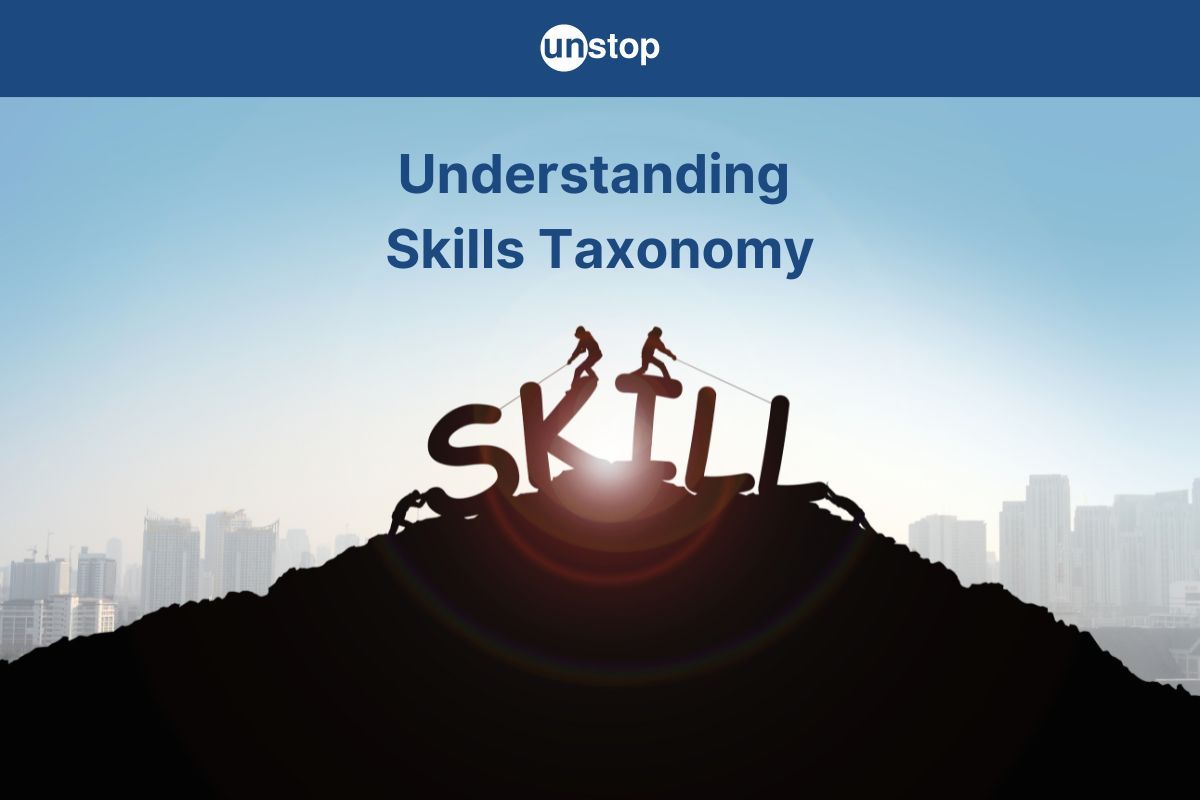
A skills taxonomy is a powerful tool that helps organizations systematically classify and organize the skills possessed by their employees. It's like a well-organized library of your workforce's capabilities, providing a clear picture of what skills you have and where there might be gaps.
In this post, we’ll delve into what skills taxonomy is, why it’s crucial, and how to implement it in your organization. Stay tuned to learn how to optimize your team’s potential through a well-defined skills framework.
Understanding Skills Taxonomy
Definition
A skills taxonomy is a hierarchical system used to classify and organize skills within an organization. Imagine it like a filing cabinet for all the skills your employees possess. Here's a breakdown of the concept:
- Structured Listing: A skills taxonomy is a structured list of skills, organized in a way that reflects their relationships and complexity.
- Hierarchical Levels: Skills are typically categorized into broad categories at the top, with more specific sub-skills listed underneath as you move down the hierarchy. This provides a clear picture of the breadth and depth of skills present within your organization.
Historical Background & Current Use
The mid-20th century saw the rise of automation and increased specialization in the workforce, which led to a growing need to identify and classify the skills required for various jobs systematically.
In the late 20th century, the development of formal skills taxonomies gained momentum. Organizations and government agencies began creating structured classification systems to categorize and manage the skills needed within their industries or sectors.
Bloom's Taxonomy, created by Benjamin Bloom in 1956, is one of the earliest examples of a classification system for learning objectives. However, Bloom's Taxonomy focuses on the cognitive domain of learning, not skills themselves.
While Bloom's Taxonomy doesn't directly represent a skills taxonomy, it played a historical role in the development of classification systems for learning and potentially influenced the development of skills taxonomies later on.
Today, organizations use skills taxonomy for various purposes:
- Recruitment: Identifying specific skills needed for job roles.
- Training: Developing targeted training programs.
- Career Development: Mapping career paths based on skill sets.
Example:
Here's a simplified example of a skills taxonomy structure:
Top Level: (Broad Skill Categories)
- Technical Skills
- Software Development Skills (sub-skills: programming languages, frameworks)
- Data Analysis Skills (sub-skills: data visualization, statistical analysis)
- Soft Skills
- Communication Skills (sub-skills: written communication, public speaking)
- Teamwork Skills (sub-skills: collaboration, conflict resolution)
- Leadership Skills
- Strategic Thinking Skills (sub-skills: problem-solving, decision-making)
- Motivational Skills (sub-skills: coaching, mentoring)
This is a basic example, and the specific categories and sub-skills will vary depending on your organization's needs.
Why do we Need Skills Taxonomy?
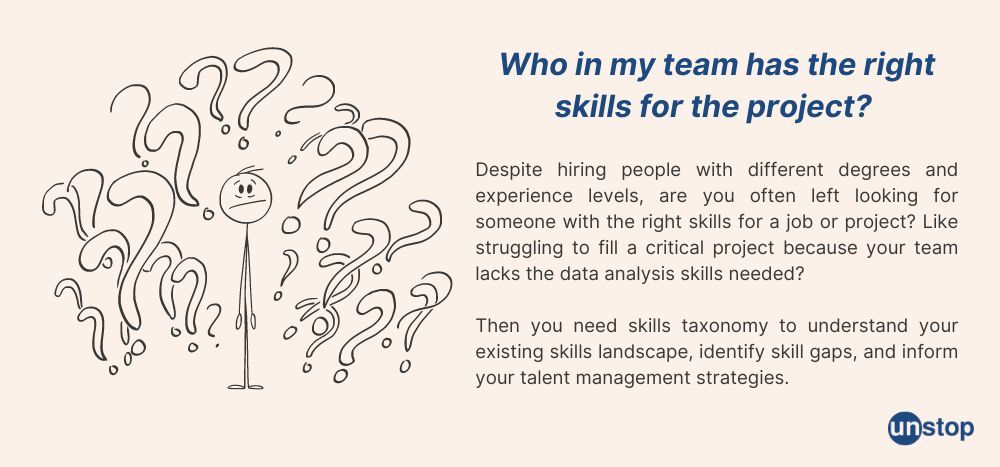
The Skills Gap Widens
A staggering 25% shift in job skillsets has occurred since 2015, according to the 2023 Workplace Learning Report. This trend is expected to accelerate, with projections reaching a 50% change by 2027. This widening gap creates a mismatch between the skills employers seek and the skills candidates present.
Closing the Gap, Building the Future: To bridge this critical skills gap and ensure a successful future workforce, employers must take a two-pronged approach:
- Precise Skill Identification: Conduct a thorough analysis to pinpoint the exact skills required for open positions. Move beyond traditional job descriptions and identify the competencies truly needed for success.
- Strategic Skills Acquisition: Prioritize hiring individuals with the necessary skills or invest in training and development programs to equip your existing workforce with the capabilities they need to thrive.
By taking these proactive steps, employers can bridge the skills gap, hire the right talent, and build a future-proof workforce ready to meet the evolving demands of the job market.
Benefits of Skills Taxonomy
Here's how a skills taxonomy can benefit your organization:
- Standardized Language: Ensures everyone uses the same terminology when discussing skills. This prevents confusion and facilitates consistent communication across departments and leadership.
- Efficient Data Analysis: By organizing skills in a structured way, a taxonomy allows for efficient data analysis of your workforce's skillsets. You can easily identify trends, skills gaps, and areas where specific skills are concentrated. This data can be used for strategic workforce planning decisions.
- Targeted Training Programs: The taxonomy helps you develop targeted training programs by pinpointing the exact skills needed for different roles and career paths. This ensures training initiatives are relevant and effective, maximizing the return on your training investment.
- Talent Management: A skills taxonomy supports strategic talent management practices. You can identify employees with transferable skills suitable for different roles, plan for future needs based on your skill inventory, and facilitate career development opportunities within your organization.
- Improved Decision-Making: By having a clear understanding of your workforce's skills, you can make data-driven decisions about hiring, promotion, and resource allocation. This equips you to build high-performing teams with the right skills to achieve strategic goals.
- Increased Employee Engagement: Knowing their skills are valued and organized can motivate employees. A skills taxonomy demonstrates your commitment to their development, fostering a culture of continuous learning and engagement.
Did you know? There's a growing trend towards skills-based hiring, evidenced by a rise in job postings that remove degree requirements.
A 2023 study by Harvard Business School's Managing the Future of Work Project and the Burning Glass Institute found that the number of roles advertised without degree requirements has nearly quadrupled since 2014. While this doesn't definitively prove a causal relationship, it suggests a shift in focus towards skills and experience.
Components of Skills Taxonomy
The key components of a skills taxonomy work together to create a structured and informative system for classifying your workforce's capabilities. Here's a breakdown of the essential elements:
1. Skill Categories: These are broad groupings of related skills. Common categories include:
- Technical Skills: Skills specific to a particular job function, like software development, data analysis, or accounting.
- Soft Skills: Interpersonal and communication skills like teamwork, problem-solving, and leadership.
- Business Skills: Skills related to business operations and management, like project management, negotiation, or financial literacy.
2. Sub-skills: These break down broad categories into more specific and measurable skills. For example, "communication" could have sub-skills like written communication, public speaking, or active listening.
3. Proficiency Levels: These define the level of mastery or expertise an employee possesses in a particular skill. Common proficiency levels include:
- Beginner: Basic understanding and ability to perform the skill with guidance.
- Intermediate: Proficient execution of the skill with some independence.
- Advanced: Expert-level skill with the ability to troubleshoot and mentor others.
4. Skill Descriptions: These provide clear definitions of each skill and its sub-skills at different proficiency levels. This ensures everyone understands what each skill entails, reducing ambiguity and confusion.
5. Skill Relationships: This component maps how different skills are related to each other. It helps identify skills that are often used together or required for the successful completion of complex tasks. This can facilitate training program development by grouping related skills for targeted learning.
6. Standardization: All of the above components should be standardized within your organization. This means using consistent terminology, definitions, and proficiency levels for all skills in your taxonomy. Standardization ensures data collected is comparable across different roles and departments, enabling meaningful analysis.
These key components work together to create a robust skills taxonomy.
Building a Skills Taxonomy: A Step-by-Step Guide
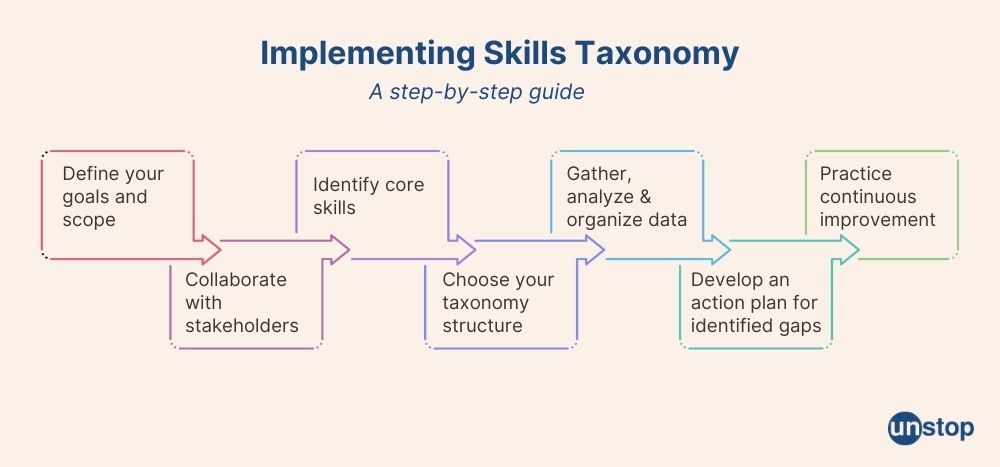
1. Define Your Goals and Scope
- Objectives: Clearly define what you want to achieve with your skills taxonomy. Is it to identify skill gaps for training purposes? Improve project allocation? Plan for future workforce needs?
- Target Audience: Decide which roles or departments will be the initial focus of your skills taxonomy development. Consider starting with critical roles, high-growth departments, or areas facing significant change.
2. Collaborate with Stakeholders
- Involve key stakeholders from various departments, including HR, department heads, and subject matter experts. Their insights will help ensure the taxonomy reflects the specific skills required across different roles.
- Consider including employees in the process. Their input can be valuable in defining relevant skills and identifying potential gaps from a firsthand perspective.
3. Identify Core Skills
- Analyze the roles within your chosen target audience. Identify the essential skills and competencies needed to perform core tasks and achieve success in those roles.
- Consider technical skills, soft skills, and leadership skills depending on the role requirements. Break down broad skill categories into more specific sub-skills or proficiency levels. For example, "communication" might be further defined as written communication, public speaking, or active listening.
4. Choose Your Taxonomy Structure
- There are various ways to structure a skills taxonomy. Popular hierarchical models organize skills into broad categories at the top, with more specific sub-skills listed underneath as you move down the hierarchy.
- You can customize the structure to suit your organization's needs. Consider factors like industry-specific skills or career development pathways.
5. Gather, Analyze & Organize Data
-
There are various ways to gather information about employee skills.
- Self-assessment surveys: Employees rate their proficiency in various skills.
- Skills tests: Practical assessments to evaluate specific technical skills.
- Performance reviews & feedback: Utilize existing data to identify strengths and weaknesses for skill development.
- Managerial input: Gather insights from managers about their team members' capabilities.
- Ensure consistency in your assessment approach. Use standardized questionnaires, rubrics, or scoring systems to evaluate skills across different roles and individuals objectively.
- Compile the collected data into a skills matrix. This visual tool maps individual employee skills against the required skills for their roles. You can utilize spreadsheets or dedicated skills management software for this purpose.
6. Identify Skill Gaps & Develop An Action Plan
- Analyze the skills matrix to identify discrepancies between the current skills and the required skills for each role. These gaps highlight areas where employees require training and development.
- Based on the identified skill gaps, create targeted training and development programs to address specific needs.
- Consider a combination of on-the-job training, workshops, online learning modules, mentorship programs, or job rotations to broaden employee skill sets and prepare them for future opportunities.
7. Continuous Improvement
- Skills mapping and taxonomy development is not a one-time activity. Regularly review and update your skills taxonomy to reflect changes in roles, company objectives, industry trends, and employee development.
- Gather feedback from employees and managers on the skills taxonomy and data collection process to refine your approach for future iterations.
By following these steps and engaging stakeholders throughout the process, you can build a robust and effective skills taxonomy that becomes a strategic tool for developing your workforce and optimizing your organization's success.
Using Complementary Tools: Skills taxonomies work well with other tools. For instance, skills ontologies provide a structured framework for understanding relationships between different skills. They enhance the functionality of a skills taxonomy framework.
Skill Taxonomies vs Intelligence Tools
This table highlights the key differences between skill taxonomy and skill intelligence tools, providing a clear comparison of their features and uses within organizational contexts:
| Feature | Skill Taxonomy | Skill Intelligence Tools |
|---|---|---|
| Definition | A structured framework that categorizes and organizes skills into a hierarchical model. | Analytical tools that leverage data to assess, track, and predict skill trends and gaps. |
| Purpose | To provide a clear understanding of skill sets and their relationships. | To offer actionable insights for workforce planning and development. |
| Structure | Hierarchical and static, often presented in tree-like diagrams. | Dynamic and data-driven, often presented through dashboards and reports. |
| Data Source | Based on predefined categories and expert input. | Derived from real-time data, including job postings, employee performance, and market trends. |
| Adaptability | Less adaptable to rapid changes in the job market. | Highly adaptable, with the ability to update based on new data inputs. |
| Usability | Primarily used for defining roles and responsibilities within an organization. | Used for strategic decision-making, such as identifying skill gaps and forecasting future needs. |
| Example | Competency frameworks, occupational standards. | Talent analytics platforms, skills gap analysis tools. |
| Implementation Complexity | Relatively straightforward but requires regular updates to remain relevant. | More complex, requiring integration with various data sources and advanced analytical capabilities. |
| Outcome | A well-defined map of skills necessary for specific roles. | Data-driven insights that inform training, hiring, and development strategies. |
Closing Thoughts
Understanding and implementing a skills taxonomy can transform how you manage talent and drive growth. By leveraging skills intelligence tools, you gain deeper insights into your team's capabilities, helping you make informed decisions. This approach not only boosts efficiency but also aligns your workforce with strategic goals.
Ready to take the next step? Start exploring skills taxonomies today and unlock your team's full potential. Dive deeper into the world of skills intelligence and see the difference it makes. Your journey to a more skilled and agile organization begins now.
Frequently Asked Questions
1. What is a skills taxonomy?
A skills taxonomy is a structured framework categorizing and defining skills. It helps organizations identify, assess, and develop employee capabilities.
2. Why are skills intelligence tools important?
Skills intelligence tools analyze and map employee skills. They provide insights for workforce planning, talent management, and training needs.
3. How does a skills-based approach benefit organizations?
A skills-based approach aligns employee development with business goals. It enhances productivity, fosters career growth, and improves job satisfaction.
4. What are the key differences between taxonomies and intelligence tools?
Taxonomies categorize skills systematically. Intelligence tools analyze these categories to offer actionable insights for decision-making.
5. How can I implement a skills taxonomy in my organization?
Start by identifying core competencies. Use software to map existing skills. Regularly update the taxonomy to reflect evolving roles and technologies.
6. What should I consider when comparing different taxonomies?
Consider the comprehensiveness, adaptability, and ease of integration with existing systems. Ensure it aligns with your organization's goals.
7. Can a skills taxonomy improve hiring processes?
Yes, it standardizes skill requirements, making it easier to match candidates with job roles accurately. This leads to better hiring decisions.
Suggested Reads:
- Productivity Paradox At Work: The Concept, Causes & Solutions Explained
- FOMO - The Critical Ingredient In Return-To-Office Initiatives
- Employee Engagement Survey: 30+ Essential Questions You Need to Ask
- How HR And Leaders Can Fix Inefficiency At Various Levels
- HR Budget: A Comprehensive Guide To Effective Planning
I’m a reader first and a writer second, constantly diving into the world of content. If I’m not writing or reading, I like watching movies and dreaming of a life by the beach.
Login to continue reading
And access exclusive content, personalized recommendations, and career-boosting opportunities.
Subscribe
to our newsletter
Blogs you need to hog!
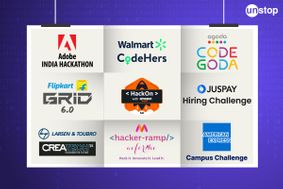
Organize Hackathons: The Ultimate Playbook With Past Case Studies

What is Campus Recruitment? How To Tap The Untapped Talent?

Lateral Hiring: A Complete Guide To The Process, Its Benefits, Challenges & Best Practices
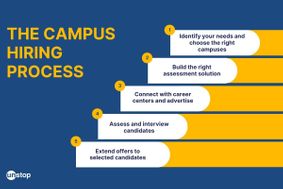








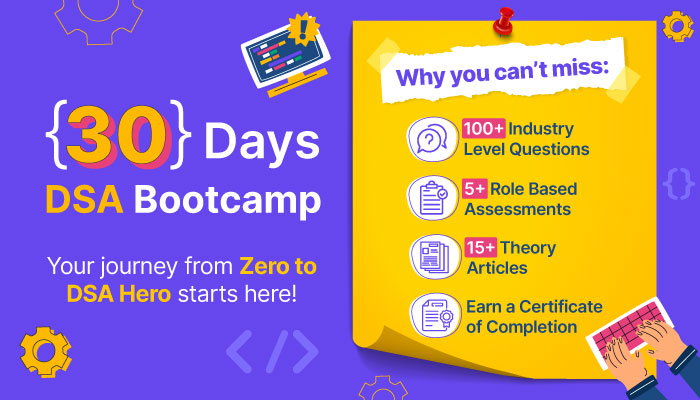



Comments
Add comment